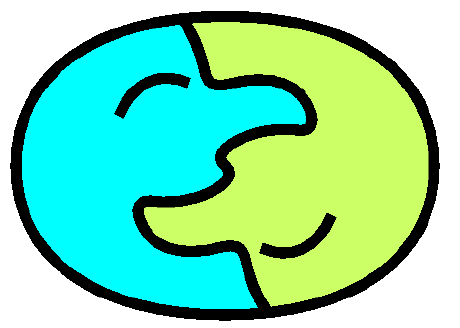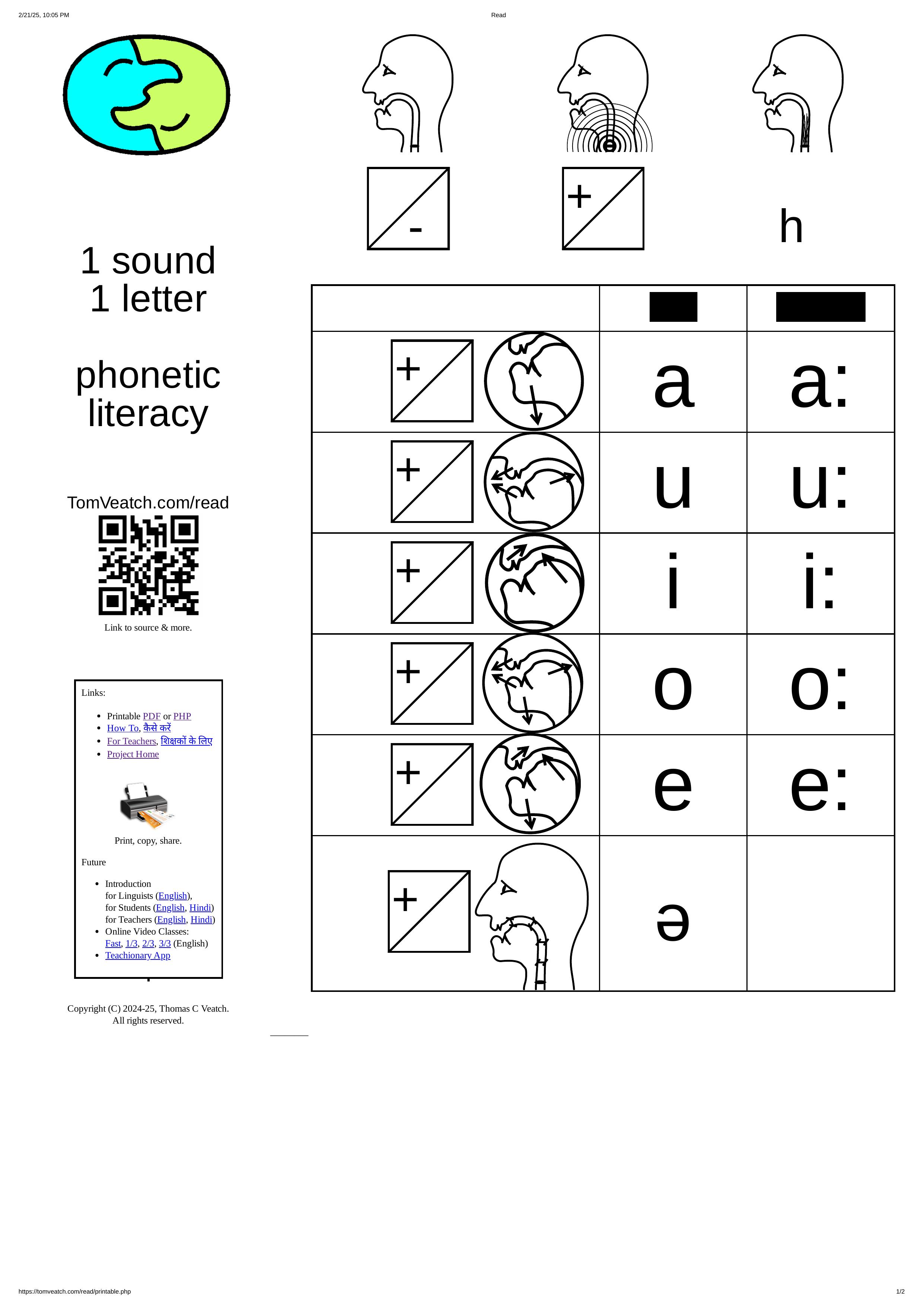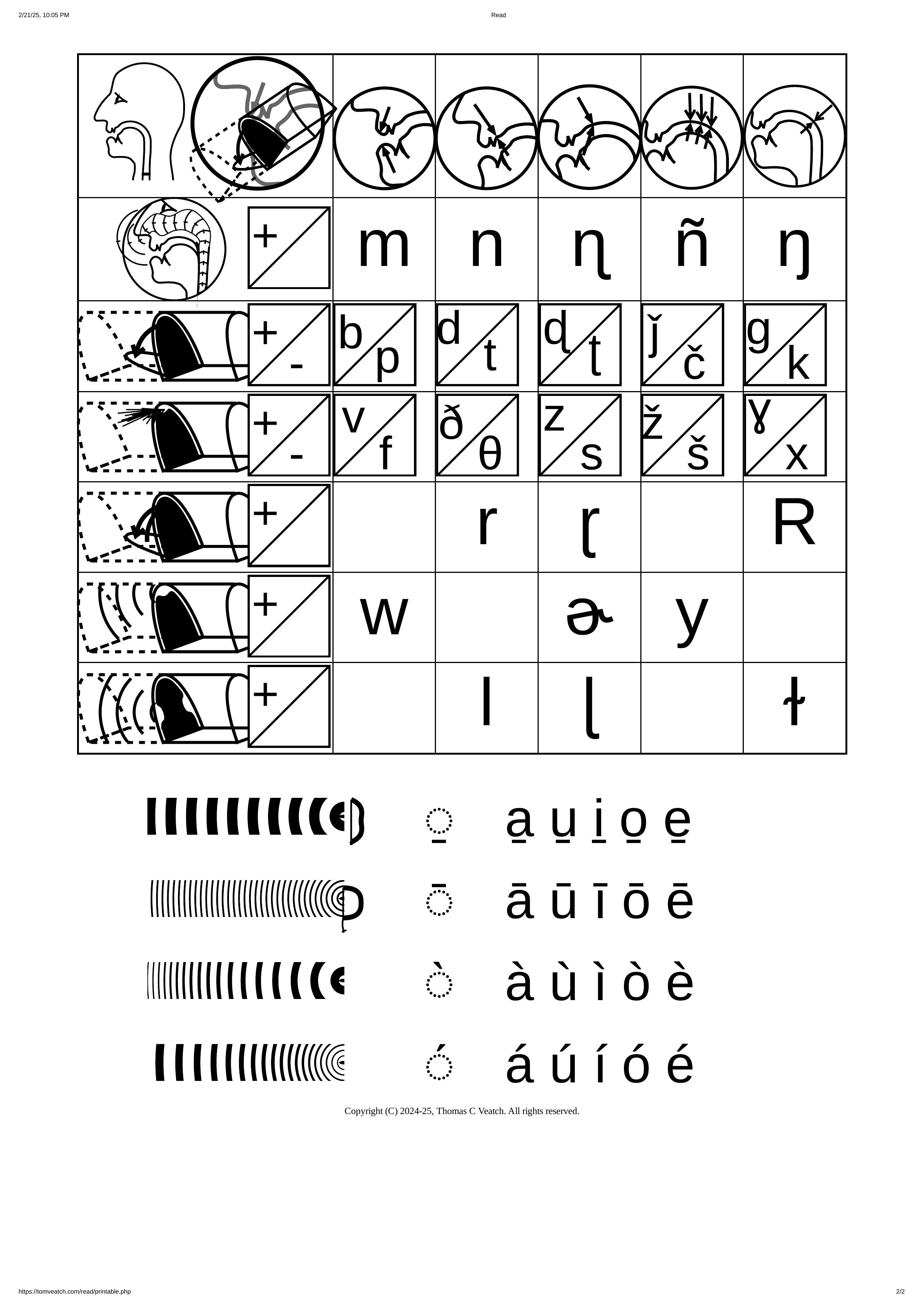May All Be Literate
IPA First for basic, practical, universal literacy
|
Tom spent February 2025 in India travelling about (daily reports here) to share and develop the teaching of phonetic literacy.
|
The Instrument:
The Call:
IPA, the International Phonetic Alphabet, is a universal doorway to literacy.
First learn IPA, with or without a teacher, with or without tech.
Then you can learn any script for any language very easily.
| If your language was unwritten, |
use IPA to write your own language.
|
| If English or European script is seen, |
use IPA to read it, mostly.
|
| To learn any new language, | use IPA to write the actual sounds |
|
because to speak it you must know the sounds.
| |
IPA offers basic phonetic literacy to all.
Download, print, copy (2 sides onto 1 page), share, explain.
Teach pre-schoolers, ladies at home, other Teachers,
everyone.
The ClaimA single two-sided sheet of paper, by itself or with a little phonetic instruction, can communicate and teach much of the International Phonetic Alphabet -- IF it uses pictures, line drawings, instead of Latin words like "fricative" or "velar". Line drawings are universal: independent of language or level.An IPA Chart with line drawings not only expands the audience (from post-graduate Linguistic Phonetics classes to Everyone -- irrespective of language or level!), but enables fundamental new modes of use. In particular, using a phonetic alphabet like IPA for initial literacy accelerates learning. By giving learners symbols for what they already know -- the sounds of (especially their own) language, in which they are already experts, we respect the important pedagogic principle of building on pre-existing knowledge. It is important to respect the students' pre-existing knowledge. They are experts not just in both production of each sound of their language, and in identification of each of them in perception, but also have mastered the implicit but profoundly abstract task of joining together the two sides of production and perception using an underlying, abstract-phonetic (i.e. phonological) form distinctively existing in the human mind and forming the abstraction-layer basis of essentially all vocabulary. The alternative, based on the list of letter names in the ABC Song, is to throw out everything students have learned by age 5 as native speakers of their language, to create and impose a previously unknown, arbitrary abstraction layer, at best confusingly related, if not entirely unrelated to the known linguistic universe, and to require all attempts at literacy to map through that misdirection-filled and often antiphonetic library. Nothing could be more harmful and obstructive to learning. On the other hand, nothing could be simpler or more intuitive than giving a distinctive letter for each of the known, distinctive sounds of a student's language, and nothing more interesting and fun than learning the other sounds that also occur in the world's languages. Furthermore, if in teaching the fundamentals of literacy we respect the one sound one letter principle, as a phonetic alphabet requires us to do, then we avoid introducing unnecessary complexity and ambiguity during the establishment of basic, transferrable, tuneable, literacy skills such as reading, writing, penmanship, the acquisition of basic domain knowledge and vocabulary, general fluency and overall competence -- all of which come much more quickly to a student undistracted and unconfused by silent letters, ambiguous forms, and the initially-irrelevant idiosyncrasies of an old and therefore semi-phonetic alphabet like that of English. Next, once the foundation is solid -- and when founded upon phonetics the foundation actually IS solid -- then other scripts can be taught with clarity and ease, not just because the second time doing something is easier than the first, but because every other script in reality has its actual definition in terms of phonetics itself, so the phonetic alphabet becomes the means of definition, the means of learning other scripts. We see this in practice in every modern dictionary, which uses the IPA to define the pronunciation of every word. The sad current world asks students to make sense of "aitch ey aitch ey" and requires them to extract "haha" from the hopelessly remote and misdirecting, intermediate representation: the ABC Song. If not a complete impossibility, it certainly violates these learning principles. On the other hand, respecting the phonetic principle, one sound one letter, transforms the problem of English literacy from the above near-impossibility to an easily, even trivially, understood problem, quickly enabling full insight and competence for the student. Once mastered, the student can then easily generalize to orthographies of any complexity -- even Chinese is taught with a phonetic alphabet, pinyin. More, in cases like India, where 80% of signage is in the widespread business language of English, the spelling although only semi-phonetic is phonetic enough that 85% of English letters by token frequency are either (1) among the phonetically reliable subset BDFJKLMVZ (12%), (2) acceptably pronounced using IPA values for the letters (another 46%), or (3) revertible to IPA (close to their historic phonetic form) using 4 consonant and 2 vowel rules (another 27%). (See a small study with these results.) To acquire 85% English literacy from a brief and intuitive exposure to the IPA plus a bit of English phonetic history, is a proposition hard to refuse even for committed-illiterate adults. The Longley Transition Reader describes how this to transition between knowing a phonetic alphabet (for English) to (English) orthography.
ThereforeEvery human should learn IPA and learn to teach IPA; IPA is really basic to being a human: knowing IPA means being able to detect and label and describe what humans actually do in reality, that is, phonetically, in doing what people mostly all do with each other, which is, in talking together. If you can't do this basic thing, how can you consider yourself a human being? Those who cannot are ignorant children who don't know what they are saying, who in matters of speaking do not know what they are talking about, and who cannot accurately even say what they or anyone else has said. It's basic.Not only basic to humanity, IPA is key to literacy, and therefore every literacy teacher has even more reasons to learn IPA, the accelerator of literacy, as argued above. (But for a punch line, see the Waltham report (#17)). Not only is it key to literacy, IPA is also easy to teach, (especially using the Entry Dance) and potentially hugely impactful on the lives of illiterate people throughout the world. Not only the 3000 unwritten languages which can all be written with IPA and therefore no longer need to be thought of as unwritten languages -- just write them with IPA! -- but the 700 million illiterate humans, who never had the opportunity to learn, all these people and languages and opportunities of giving and teaching are hungrily waiting for us today, just wishing that someone would open the door to include the excluded, by revealing the simple secrets of literacy in some accessible format. Therefore, every traveller to every corner of the globe where illiterate people reside, yes, dear ones, you!: Please learn the IPA, please patronize the local copy shops and stationery stores and carry with you copies of the Instrument and plenty of supplies of practice notebooks and pens with you, and please take the time to show it to folks you meet if you guess they might be illiterate, and take the time to teach it to those you show it to who hold the paper upside down. Such a person, you may change their life, and the prospects of their whole family. You will be happy you did. Further 2025 DevelopmentsAnnouncing the first Veatch Scientist for Phonetic Literacy is Hariprasad Doley, PhD student in Linguistics at Jawaharlal Nehru University in Delhi.We are meeting weekly and preparing experiments to hopefully verify claims of accelerated literacy learning through reading phonetics first. See notes here.
|


